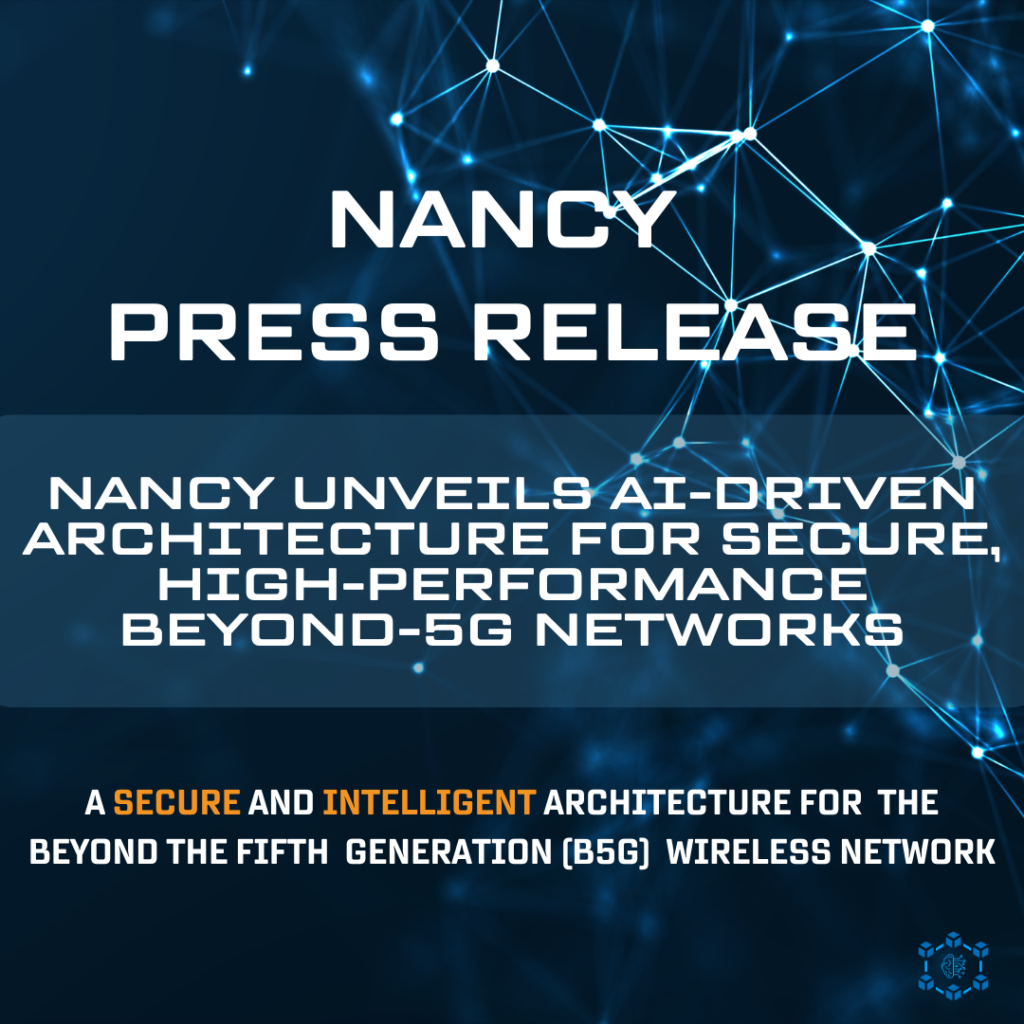The NANCY project is shaping the future of wireless connectivity with a groundbreaking AI-powered network architecture that delivers secure, high-performance services beyond 5G. By integrating blockchain-enhanced trust mechanisms, self-evolving AI orchestration, and edge-level virtualization, NANCY is paving the way for faster, more reliable, and more intelligent networks for industries and citizens across Europe.
What’s new in NANCY?
- Next-Generation Architecture: A comprehensive design framework combining blockchain for trust, quantum-safe mechanisms, and cell-free access, ensuring security and resilience.
- Smarter Core Services: Advanced functionalities such as spectrum sensing, anomaly detection, localization, and throughput forecasting, enabling highly responsive and time-sensitive network operations.
- AI That Learns & Adapts: An AI orchestrator that manages and retrains models automatically, ensuring optimal performance without human intervention.
- Virtualization Reinvented: A novel partition-based virtualization framework for orchestrating edge resources in real-time without the typical overhead of traditional hypervisors.
Key Innovations in Action
- NAOMI (Self-Evolving Model Repository): Automates retraining to detect and fix performance drifts.
- Inter-Slice Protocol Learning: Reinforcement-learning agents dynamically share resources, reducing conflicts and boosting efficiency.
- vManager (Partition-Based Virtualization): Enables real-time, hardware-level orchestration for latency-sensitive applications.
- Time-Sensitive Orchestration: Guarantees bandwidth and latency for mission-critical tasks.

Why it matters
For telecom operators, this means greater control over network slicing. For European manufacturers and service providers, it means competitive B5G offerings. For citizens, it means more reliable mobile broadband, safer communications, and smarter services—from connected vehicles to advanced public safety systems.
“In NANCY, we’ve bridged AI research and real network demands to deliver a secure, flexible foundation for the next generation of mobile connectivity.”
— Dr. Carolina Fortuna, Jožef Stefan Institute
See it in action:
Check out our localization demo with AI-driven orchestration for autoscaling: Watch here.
Further Reading:
Čop, Andrej, Blaž Bertalanič, and Carolina Fortuna. “An overview and solution for democratizing AI workflows at the network edge.” Journal of Network and Computer Applications (2025): 104180.
Bertalanič, Blaž, Jernej Hribar, and Carolina Fortuna. “Visibility graph-based wireless anomaly detection for digital twin edge networks.” IEEE Open Journal of the Communications Society 5 (2024): 3050-3065.
Panagopoulou, A., Rigo, A., & Raho, D. (2024, November). Cross-Compartment Virtio-Loopback: A Bare-Metal Virtualization Solution for the Edge. In 2024 IEEE International Conference on Electrical Systems for Aircraft, Railway, Ship Propulsion and Road Vehicles & International Transportation Electrification Conference (ESARS-ITEC) (pp. 1-6). IEEE.
Rezazadeh, F., Chergui, H., Siddiqui, S., Mangues, J., Song, H., Saad, W., & Bennis, M. (2024). Intelligible protocol learning for resource allocation in 6g o-ran slicing. IEEE Wireless Communications, 31(5), 192-199.
Casini, D., Pazzaglia, P., & Becker, M. (2025). Managing real-time constraints through monitoring and analysis-driven edge orchestration. Journal of Systems Architecture, 163, 103403.
Stay up to date with NANCY’s results and upcoming demonstrations:
- 🌐Website: https://nancy-project.eu
- 📺Youtube: @nancy-snsju-project
- 💼LinkedIn: @nancy-snsju-project
- 🐦X (Twitter): @NANCY_snsju
- 📘Facebook: @NANCY.SNSJU.Project
NANCY is a Horizon Europe project funded by the Smart Networks and Services Joint Undertaking (SNS JU). NANCY brings together 24 partners from 9 European countries to design a secure, intelligent, and energy-efficient architecture for Beyond 5G (B5G) networks.
The project has received funding from the Smart Networks and Services Joint Undertaking (SNS JU) under the European Union’s Horizon Europe research and innovation programme under Grant Agreement No 101096456. Views and opinions expressed are however those of the author(s) only and do not necessarily reflect those of the European Union or SNS JU. Neither the European Union nor the SNS JU can be held responsible for them.







